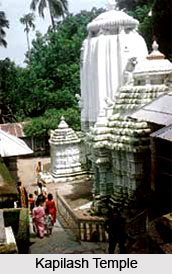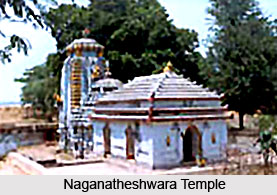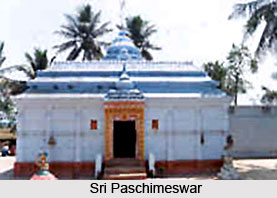 Pilgrimage tourism in Dhenkanal District basically consists of several ancient temples. These temples are worth visiting and a large number of people visit them every year. Due to rich cultural heritage and spiritual height Dhenkanal is dotted with innumerable temples, maths (abbeys) dating back to ancient times. All sects of Brahmanism like Saivism, Vaishnavism, Shaktism and other minor sects have plenty of their holy places.
Pilgrimage tourism in Dhenkanal District basically consists of several ancient temples. These temples are worth visiting and a large number of people visit them every year. Due to rich cultural heritage and spiritual height Dhenkanal is dotted with innumerable temples, maths (abbeys) dating back to ancient times. All sects of Brahmanism like Saivism, Vaishnavism, Shaktism and other minor sects have plenty of their holy places.
Shiva Temples in Dhenkanal District:
Kapilash Temple: It is situated in the north east corner of Dhenkanal town at a distance of 26 km from the district head quarters. The temple is situated in about 2239 feet from the sea level and it is 60 feet in height. Narasinghdeva-I constructed the temple for Sri Chandrasekhar in 1246 AD. In the left side of the temple, `Payamruta kunda` and in the right side `Marichi kunda` exists. Lord Biswanath Temple is also situated in Kapilash. According to some scholars this temple is older than the Chandrasekahr Jew Temple, hence it is also known as `Budha linga`. There are many legends about Kapilash pitha and its significance. History says it was the ashram of Kapila muni, to some scholars it is considered as the second Kailash of Lord Shiva. Sridhar Swami who wrote commentary on Srimad Bhagavatham stayed there. There are some monasteries also in the premises.
Naganatheshwara Temple: This temple belongs to Sri Naganatheshwara Shiva, situated at village `Nagena` about 20 km from Dhenkanal. It is an ancient temple and was constructed during the reign of the Keshari Dynasty. Near this temple, there are remains of a fort which is still unidentified. Brahmani River flows through this region.
 Astasambhu Temple: Kualo or Karmula was the ancient capital of Dhenkanal. Kualo is situated in north of Dhenkanal town at a distance of around 32 km on the right side of Brahmani River. The kingdom was ruled by the Shulki kings who hold `stamba` epithets. They were the feudatories of the Bahmukar kings. They worshiped Lord Shiva. There are eight Shiva temples at Kualo known as `Ashta Sambhu`. These eight Shiva lingas are known as - Kanakeswar, swapneswar, Aisneswar, Kapileswar, Baidyanatheswar, Bane and Lokanatheswar.
Astasambhu Temple: Kualo or Karmula was the ancient capital of Dhenkanal. Kualo is situated in north of Dhenkanal town at a distance of around 32 km on the right side of Brahmani River. The kingdom was ruled by the Shulki kings who hold `stamba` epithets. They were the feudatories of the Bahmukar kings. They worshiped Lord Shiva. There are eight Shiva temples at Kualo known as `Ashta Sambhu`. These eight Shiva lingas are known as - Kanakeswar, swapneswar, Aisneswar, Kapileswar, Baidyanatheswar, Bane and Lokanatheswar.
Sri Kanakeswar: It is one of the Ashta Shambhu Siva and situated near Ramachandi temple.
Sri Annakoteswar: Situated at Latadeipur. The significance of this Shiva linga is that it grooms in the bright fortnight and reduces on the dark half.
The other Shiva temples besides the above temples are as follows -
Sri Paschimeswar: Situated near Bhapur, this temple was constructed in the 7th AD by the Shambhu Vamsi kings.
Sri Daudeswar: This temple is situated on the banks Brahmani River.
Kapileswar Temple: This temple is situated in village Hatuari (near Badasuanlo).
Sri Budheswar: This temple is situated near Bhuban on the bank of river Brahmani .It is related to the mythology that Lord Kartikeya after taking holy bath in the river had the darshan of Lord Shiva.
Sri Bishwanatheswar: This temple is situated in the village mandu khura.
Sri Kamaleswar: This temple is situated near Kamalanga on the bank of river Brahmani.
Vaishnava Temples in Dhenkanal District: Vaishnavism in different form had its impact in Dhenkanal in different ages. The Ramanandi Vaisnavas, the Gaudiya Vaisnavas, the Pancharattra all developed side by side in the district.
 Some of the famous Vaishnava temples of Dhenkanal District are mentioned below -
Some of the famous Vaishnava temples of Dhenkanal District are mentioned below -
Siddaha Balaram Temple: Siddha Balaram temple at Dhenkanal town is the pivotal figure of the Vaishnava cult in the district. History says that Anangabhima III brought Sri Balaram from Talmul to Bhima Nagari Garh in 12th -13th Centuries AD. While he was taking the image to Puri, Sri Balaram ordered him to give up the effort. Hence, he built Dasakamba Mandala at Chittala pur near Hindol. Hari singh Vidhyadhara defeated the Bhanja King and brought the image of Balaram to Dhenkanal. He started construction of the temple in 1590 AD. The main temple is 90 feet high. The construction of gateway of the temple, the boundary wall was completed in between 1708 to 1741 AD. The Balaram temple follows the rituals like Sri Mandir of Puri and observes several auspicious days through out the year.
Thus, these temples offer peaceful pilgrimage tourism to the travellers in Dhenkanal District.



















